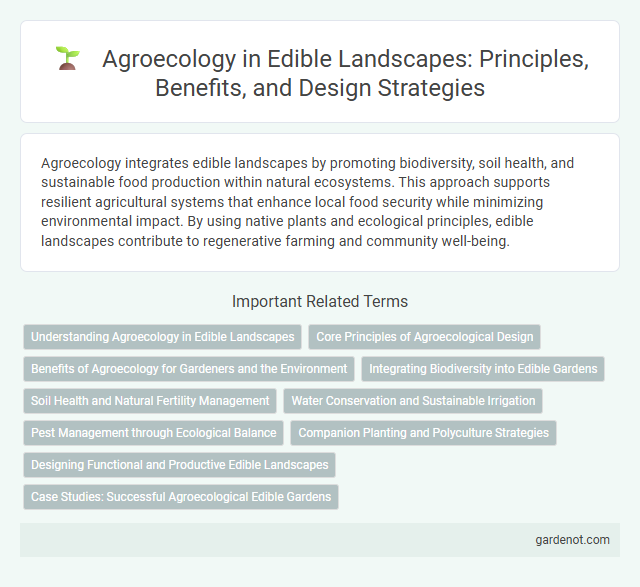Agroecology integrates edible landscapes by promoting biodiversity, soil health, and sustainable food production within natural ecosystems. This approach supports resilient agricultural systems that enhance local food security while minimizing environmental impact. By using native plants and ecological principles, edible landscapes contribute to regenerative farming and community well-being.
Understanding Agroecology in Edible Landscapes
Agroecology in edible landscapes integrates ecological principles with agricultural practices to create sustainable food systems that enhance biodiversity and soil health. It emphasizes crop diversity, natural pest control, and organic composting to promote resilience and productivity without synthetic inputs. Understanding these practices supports the development of edible landscapes that contribute to food security and environmental sustainability.
Core Principles of Agroecological Design
Agroecological design integrates biodiversity, nutrient cycling, and ecological interactions to create sustainable edible landscapes that enhance soil health and water retention. Emphasizing polycultures, seasonal diversity, and resource efficiency, this approach reduces external inputs while supporting resilience against pests and climate variability. Key principles include mimicking natural ecosystems, promoting local knowledge, and fostering social equity to achieve long-term productivity and environmental balance.
Benefits of Agroecology for Gardeners and the Environment
Agroecology enhances soil health and biodiversity by promoting natural pest control and nutrient cycling, resulting in resilient edible landscapes for gardeners. This sustainable approach reduces chemical inputs and water usage, contributing to environmental conservation. Gardeners benefit from increased crop diversity and higher yields, supporting local ecosystems and food security.
Integrating Biodiversity into Edible Gardens
Integrating biodiversity into edible gardens enhances ecosystem resilience by attracting pollinators, natural predators, and beneficial microorganisms that improve soil health and pest control. Agroecology principles promote diverse plant species combinations, including native flora, to create balanced, self-sustaining systems that optimize nutrient cycling and increase crop yields. Such practices contribute to climate adaptation, promote sustainable food production, and support local wildlife habitats within urban and rural landscapes.
Soil Health and Natural Fertility Management
Agroecology in edible landscapes emphasizes soil health through practices such as crop rotation, cover cropping, and organic mulching to enhance natural fertility management. Incorporating compost and biochar improves soil structure and microbial activity, promoting nutrient cycling without synthetic inputs. These methods sustain long-term productivity and resilience, reducing erosion and increasing biodiversity essential for healthy edible ecosystems.
Water Conservation and Sustainable Irrigation
Agroecology promotes water conservation by integrating edible landscapes with sustainable irrigation techniques such as drip irrigation and rainwater harvesting, reducing water waste and enhancing soil moisture retention. Utilizing native plants and mulching further supports efficient water use and ecosystem resilience. These practices optimize resource management, ensuring long-term productivity and environmental sustainability in agroecosystems.
Pest Management through Ecological Balance
Agroecology leverages natural pest management by promoting biodiversity and ecological balance within edible landscapes, reducing reliance on synthetic pesticides. Incorporating companion plants, beneficial insects, and habitat diversification enhances pest control through predator-prey interactions and natural repellents. This sustainable approach improves crop resilience, soil health, and overall ecosystem stability while maintaining food production efficiency.
Companion Planting and Polyculture Strategies
Agroecology employs companion planting and polyculture strategies to enhance biodiversity and soil health in edible landscapes. Companion planting involves growing complementary crops together, such as basil with tomatoes, which can deter pests and improve growth. Polyculture diversifies plant species within the same space, promoting pest control, nutrient cycling, and resilient ecosystems for sustainable food production.
Designing Functional and Productive Edible Landscapes
Designing functional and productive edible landscapes integrates principles of agroecology to enhance biodiversity, soil health, and ecosystem services while maximizing food yields. Utilizing native plants, companion planting, and water-efficient irrigation systems promotes sustainable resource use and resilience against pests and climate variability. Such landscapes transform urban and rural spaces into multifunctional environments that provide nutrition, habitat, and ecological balance.
Case Studies: Successful Agroecological Edible Gardens
Agroecological principles have been effectively applied in numerous edible landscape projects worldwide, showcasing sustainable food production and biodiversity enhancement. Case studies from Cuba's urban organoponicos demonstrate high-yield, soil-friendly methods that foster community resilience and reduce urban food deserts. Similarly, Brazil's agroecological schools integrate edible gardens to promote ecological education and local food sovereignty through diverse crops and organic practices.
Agroecology Infographic

 gardenot.com
gardenot.com